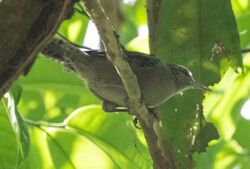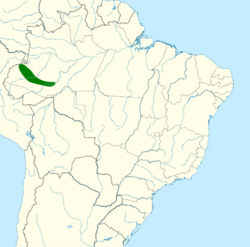Biology:Grey wren
| Grey wren | |
|---|---|

| |
| Scientific classification | |
| Domain: | Eukaryota |
| Kingdom: | Animalia |
| Phylum: | Chordata |
| Class: | Aves |
| Order: | Passeriformes |
| Family: | Troglodytidae |
| Genus: | Cantorchilus |
| Species: | C. griseus
|
| Binomial name | |
| Cantorchilus griseus (Todd, 1925)
| |

| |
| Synonyms | |
|
Thryothorus griseus, Odontorchilus olallae[1] | |
The grey wren (Cantorchilus griseus) is a species of bird in the family Troglodytidae. It is endemic to the southwestern part of Amazonas state in Brazil . This small, poorly known wren somewhat resembles a house wren, but its upperparts are gray.
Taxonomy and systematics
The grey wren, with many other Cantorchilus wrens, was originally included in genus Thryothorus, but that genus was determined to be paraphyletic. There are suggestions that the species may warrant its own genus because it is quite different from the rest of genus Cantorchilus.[1][2]
Description
The grey wren is 11.5 cm (4.5 in) long. The adults have a lead-gray crown and upperparts; the tail is also gray with broad blackish bars. It has a faint whitish supercilium and the rest of the face is gray. The throat is whitish gray, the chest gray, and the belly a slightly buffy gray. It differs from others of its genus in its smaller overall size, its shorter tail, the gray plumage, and the absence of prominent facial markings.[2]
Distribution and habitat
The grey wren is known only from a small area of Brazil, along the right bank of the Rio Javarí and the upper reaches of the Rio Juruá and Rio Purus to the southeast. The Rio Javari forms the border with Peru but the species is unknown on that side (the left bank) of the river. It is a bird of thick vegetation, inhabiting overgrown clearings and the undergrowth of várzea forest. In elevation it ranges only as high as 200 m (660 ft).[2]
Behavior
Feeding
The grey wren's diet has not been documented. It is known to forage in pairs and small family groups in its habitat's tangled undergrowth.[2]
Breeding
No information has been published about the grey wren's breeding phenology.[2]
Vocalization
The grey wren's song is "a repeated phrase of 2 or 3 notes, 'chu-choww' or 'chippit, chippit'".[2]
Status
The IUCN has assessed the grey wren as being of Least Concern.[3] Though it appears to be common in parts of its range, it needs much further study.[2]
References
- ↑ 1.0 1.1 Remsen, J. V., Jr., J. I. Areta, E. Bonaccorso, S. Claramunt, A. Jaramillo, D. F. Lane, J. F. Pacheco, M. B. Robbins, F. G. Stiles, and K. J. Zimmer. Version 23 May 2021. A classification of the bird species of South America. American Ornithological Society. https://www.museum.lsu.edu/~Remsen/SACCBaseline.htm retrieved May 24, 2021
- ↑ 2.0 2.1 2.2 2.3 2.4 2.5 2.6 Kroodsma, D. E. and D. Brewer (2020). Gray Wren (Cantorchilus griseus), version 1.0. In Birds of the World (J. del Hoyo, A. Elliott, J. Sargatal, D. A. Christie, and E. de Juana, Editors). Cornell Lab of Ornithology, Ithaca, NY, USA. https://doi.org/10.2173/bow.grywre1.01 retrieved June 7, 2021
- ↑ Cite error: Invalid
<ref>tag; no text was provided for refs namedIUCN
Wikidata ☰ Q622980 entry
 |


